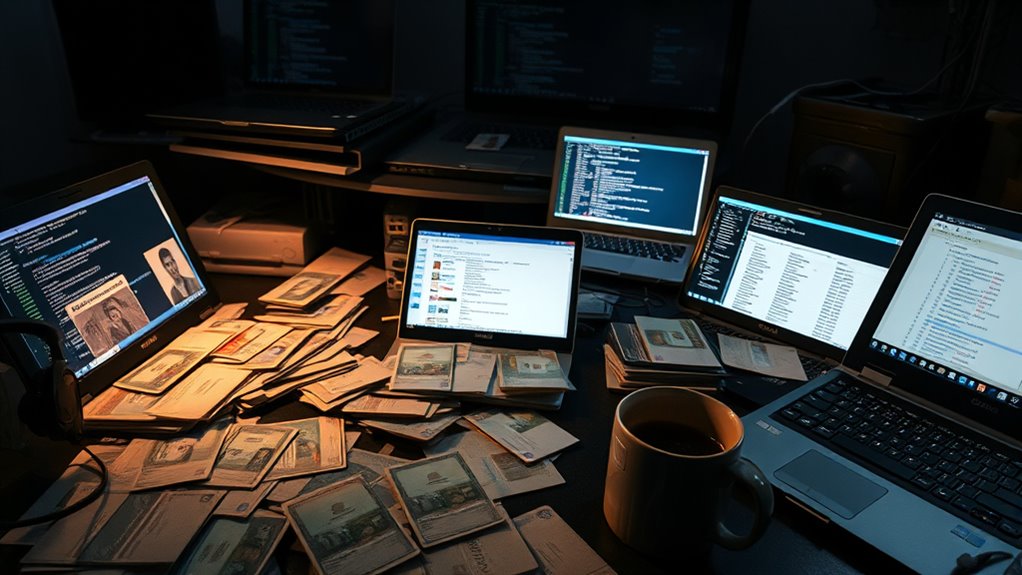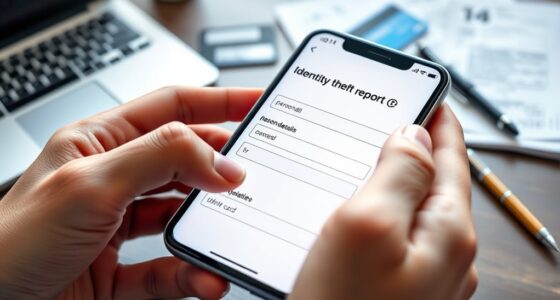Criminals build fullz by collecting personal details from data breaches, phishing, and underground markets, piecing together information like your name, SSN, and bank info. They use automated tools and targeted scams to gather data from multiple sources, making it easier to impersonate you or steal your finances. Protecting your digital identity with strong passwords, monitoring accounts, and staying alert can help stop them. Keep going to uncover more ways to guard yourself.
Key Takeaways
- Criminals gather data from breaches, phishing, and underground markets to compile comprehensive ‘fullz’ profiles.
- They piece together personal info from multiple sources to create detailed identities for impersonation.
- Protecting personal data with strong passwords and two-factor authentication reduces the risk of fullz creation.
- Regularly monitoring credit reports and setting alerts can detect suspicious activity early.
- Staying informed about scams and reporting suspicious activity helps prevent criminals from assembling ‘fullz’.

Criminals often piece together “fullz”—comprehensive sets of stolen personal information—to carry out identity theft and financial fraud. These fullz include details like your name, date of birth, Social Security number, bank account information, and even login credentials. They’re meticulously assembled from various sources, making it easier for fraudsters to impersonate you and access your finances or personal accounts. Your digital identity is the foundation they exploit, so understanding how these pieces come together is vital for fraud prevention.
Most criminals gather information through data breaches, phishing schemes, or buying stolen data on underground markets. Once they have enough details, they create a convincing digital identity that can pass as yours in online transactions or customer verification processes. This is why safeguarding your digital identity is essential. It’s not just about protecting your personal data but also about controlling how your information is shared and accessed online. Using strong, unique passwords, enabling two-factor authentication, and regularly checking your accounts helps you maintain control over your digital identity and prevents hackers from assembling a fullz.
Criminals create convincing digital identities by exploiting data breaches, phishing, and underground markets—protect your online accounts and info.
Fraud prevention methods are your best defense against this kind of theft. Monitoring your credit reports for unfamiliar activity, setting up account alerts, and being skeptical of unsolicited requests for personal information can stop criminals in their tracks. Remember, fraudsters often use social engineering tactics to trick you into revealing details or clicking malicious links. Staying vigilant and verifying the legitimacy of any communication involving your data is essential. If you notice anything suspicious, report it promptly to your financial institutions and credit bureaus.
Additionally, consider using identity theft protection services that alert you to suspicious activity related to your personal data. These services can help detect attempts to misuse your digital identity before they escalate into full-blown fraud. Educating yourself about common scams and the ways criminals try to piece together fullz heightens your awareness and resilience. The more you understand how your information is targeted and exploited, the better you can implement effective fraud prevention strategies. Remember, your digital identity is a valuable asset—guard it carefully, and stay proactive in protecting yourself from those who seek to steal it. Recognizing the sources of personal data used in these schemes can further enhance your security measures.
Frequently Asked Questions
How Do Criminals Verify the Accuracy of ‘Fullz’ Information?
Criminals verify the accuracy of ‘fullz’ information through identity verification methods, such as cross-checking details against public records, social media, or data breaches. They often test the data by making small transactions or inquiries to see if the details match real accounts. This process helps them confirm data accuracy and avoid detection, allowing them to use the stolen information effectively while minimizing the risk of fraud detection.
What Role Do Data Breaches Play in Building ‘Fullz’?
Data breaches are the treasure chests where criminals find the keys to building ‘fullz’. They scoop up stolen info, turning a breach into a gold mine for identity theft. These breaches have serious consequences, exposing personal data and fueling fraud. To prevent this, focus on identity theft prevention strategies, like strong passwords and monitoring your credit. Staying vigilant helps you turn the tide against cybercriminals using breached data.
Are There Legal Ways to Detect if Your Data Is Part of a ‘Fullz’?
You can use legal detection methods like data monitoring services to check if your information appears in a ‘fullz.’ These tools scan various databases and alert you to potential breaches or misuse of your data. Regularly monitoring your credit reports and bank accounts helps spot suspicious activity early. Staying vigilant and using authorized security services gives you a better chance to catch malicious use of your data before serious damage occurs.
How Effective Are Current Cybersecurity Measures Against ‘Fullz’ Creation?
It’s surprising how effective current cybersecurity measures are against ‘fullz’ creation, especially when you consider encryption methods and fraud detection. When your data is safeguarded with strong encryption, criminals find it harder to piece together complete profiles. Advanced fraud detection systems also flag suspicious activity early, making it tougher for ‘fullz’ to be assembled unnoticed. While no system is perfect, these measures considerably reduce your risk of falling victim.
Can Individuals Prevent Their Information From Being Used to Build ‘Fullz’?
You can prevent your information from being used in identity theft by practicing strong data protection. Always use unique, complex passwords, enable two-factor authentication, and stay vigilant about phishing scams. Regularly monitor your financial statements and credit reports for suspicious activity. Be cautious about sharing personal details online, and secure your devices. These proactive steps help reduce the risk of criminals building ‘fullz’ and protect your personal data from misuse.
Conclusion
Now that you understand how criminals craft ‘fullz,’ you realize it’s a constant game of cat and mouse. They adapt, innovate, and find new ways to exploit vulnerabilities. But knowledge is your best weapon. Staying vigilant and aware might just be the difference between falling victim or stopping them in their tracks. The fight isn’t over—it’s just beginning. Will you be ready when the next move comes? The choice is yours.









